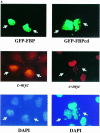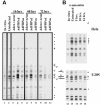Loss of FBP function arrests cellular proliferation and extinguishes c-myc expression
- PMID: 10698944
- PMCID: PMC305642
- DOI: 10.1093/emboj/19.5.1034
Loss of FBP function arrests cellular proliferation and extinguishes c-myc expression
Abstract
The c-myc regulatory region includes binding sites for a large set of transcription factors. The present studies demonstrate that in the absence of FBP [far upstream element (FUSE)-binding protein], which binds to the single-stranded FUSE, the remainder of the set fails to sustain endogenous c-myc expression. A dominant-negative FBP DNA-binding domain lacking effector activity or an antisense FBP RNA, expressed via replication-defective adenovirus vectors, arrested cellular proliferation and extinguished native c-myc transcription from the P1 and P2 promoters. The dominant-negative FBP initially augmented the single-stranded character of FUSE; however, once c-myc expression was abolished, melting at FUSE could no longer be supported. In contrast, with antisense FBP RNA, the single-stranded character of FUSE decreased monotonically as the transcription of endogenous c-myc declined. Because transcription is the major source of super-coiling in vivo, we propose that by binding torsionally strained DNA, FBP measures promoter activity directly. We also show that FUSE is predicted to behave as a torsion-regulated switch poised to regulate c-myc and to confer a higher order regulation on a large repertoire of factors.
Figures











Similar articles
-
A transactivator of c-myc is coordinately regulated with the proto-oncogene during cellular growth.Oncogene. 1995 Jun 1;10(11):2229-38. Oncogene. 1995. PMID: 7784068
-
NMR-driven discovery of benzoylanthranilic acid inhibitors of far upstream element binding protein binding to the human oncogene c-myc promoter.J Med Chem. 2004 Sep 23;47(20):4851-7. doi: 10.1021/jm0497803. J Med Chem. 2004. PMID: 15369388
-
A sequence-specific, single-strand binding protein activates the far upstream element of c-myc and defines a new DNA-binding motif.Genes Dev. 1994 Feb 15;8(4):465-80. doi: 10.1101/gad.8.4.465. Genes Dev. 1994. PMID: 8125259
-
C-MYC: evidence for multiple regulatory functions.Semin Cancer Biol. 1990 Feb;1(1):69-80. Semin Cancer Biol. 1990. PMID: 2133113 Review.
-
Differentiation primary response genes and proto-oncogenes as positive and negative regulators of terminal hematopoietic cell differentiation.Stem Cells. 1994 Jul;12(4):352-69. doi: 10.1002/stem.5530120402. Stem Cells. 1994. PMID: 7951003 Review.
Cited by
-
The expression of FBP1 after traumatic brain injury and its role in astrocyte proliferation.J Mol Neurosci. 2013 Nov;51(3):687-94. doi: 10.1007/s12031-013-0049-x. J Mol Neurosci. 2013. PMID: 23797733
-
Defining the essential function of FBP/KSRP proteins: Drosophila Psi interacts with the mediator complex to modulate MYC transcription and tissue growth.Nucleic Acids Res. 2016 Sep 19;44(16):7646-58. doi: 10.1093/nar/gkw461. Epub 2016 May 20. Nucleic Acids Res. 2016. PMID: 27207882 Free PMC article.
-
FBPs are calibrated molecular tools to adjust gene expression.Mol Cell Biol. 2006 Sep;26(17):6584-97. doi: 10.1128/MCB.00754-06. Mol Cell Biol. 2006. PMID: 16914741 Free PMC article.
-
Identification of FUBP1 as a Long Tail Cancer Driver and Widespread Regulator of Tumor Suppressor and Oncogene Alternative Splicing.Cell Rep. 2019 Sep 24;28(13):3435-3449.e5. doi: 10.1016/j.celrep.2019.08.060. Cell Rep. 2019. PMID: 31553912 Free PMC article.
-
Molecular Pathogenesis of Low-Grade Glioma.Neurosurg Clin N Am. 2019 Jan;30(1):17-25. doi: 10.1016/j.nec.2018.08.011. Neurosurg Clin N Am. 2019. PMID: 30470401 Free PMC article. Review.
References
-
- Aghib D.F., Bishop, J.M., Ottolenghi, S., Guerrasio, A., Serra, A. and Saglio, G. (1990) A 3′ truncation of MYC caused by chromosomal translocation in a human T-cell leukemia increases mRNA stability. Oncogene, 6, 707–711. - PubMed
-
- Avigan M.I., Strober, B. and Levens, D. (1990) A far upstream element stimulates c-myc expression in undifferentiated leukemia cells. J. Biol. Chem., 265, 18538–18545. - PubMed
-
- Baber J.L., Libutti, D., Levens, D. and Tjandra, N. (1999) High precision solution structure of the C-terminal KH domain of heterogeneous nuclear ribonucleoprotein K, a c-myc transcription factor. J. Mol. Biol., 18, 949–962. - PubMed
-
- Bazar L., Meighen, D., Harris, V., Duncan, R., Levens, D. and Avigan, M. (1995). Targeted melting and binding of a DNA regulatory element by a transactivator of c-myc. J. Biol. Chem., 270, 8241–8248. - PubMed
MeSH terms
Substances
LinkOut - more resources
Full Text Sources
Other Literature Sources
Miscellaneous

